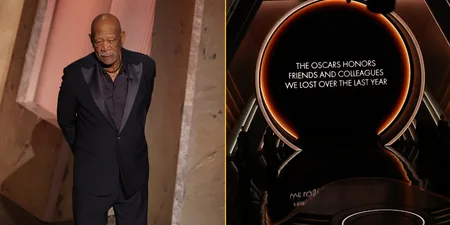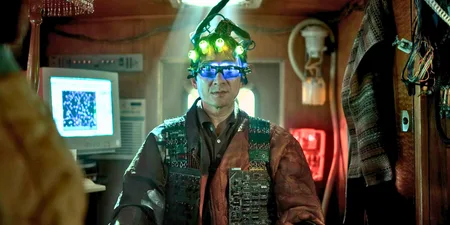Get Rich or Die Tryin’ changed my life.
Can you believe it’s been 15 years since the release of Get Rich or Die Tryin’? Nah, me either. It seems like it was just yesterday I was sporting the latest G-Unit Reebok kicks and whatever G-Unit Ecko clothing I could get my hands on while screaming, “G, G, G, G, G, G, G-Unit!” at the top of my voice.
When 50 Cent dropped his classic debut album everything changed. Music changed. Culture changed. Hell, my life changed. It was like the second coming of Michael Jackson’s Thriller.
In the world of pop culture, nothing since its release has been as big or as influential – this is just facts. Drake’s current run is impressive, but it’s not even close to achieving the same level of hysteria surrounding 50 Cent’s 2002-2007 un-fuck-wit-able run. It was like witnessing a Hip Hop Presidential campaign take place – he was everywhere.
And before you say it, neither Lil’ Wayne’s mid-2000s run nor Adele’s record-breaking 2015, where her album 25 sold over three million copies in a single week, come close.
Get Rich or Die Tryin’ was more than just music.
Prior to the album’s release you already felt like you knew 50 Cent. You might not have known him personally, but you knew his story. This intriguing and unquestionably intense narrative is what contributed to 50’s whirlwind rise to superstardom. It’s the same narrative that was later recreated in the Jim Sheridan-directed 2005 movie of the same name.
Time for a quick backstory.
Curtis “50 Cent” Jackson was the son of a drug-dealing mother who unfortunately met her demise when she was murdered in 1983. He then embraced the drug dealer lifestyle himself before turning to music. It was Jam Master Jay of Run DMC that took a chance on him, taught him how to structure songs, taught him how to be a better MC. Then Columbia Records came knocking and he signed an album deal, the result was the Trackmasters executive produced Power of the Dollar.
Power of the Dollar never saw the light of day because 50 was infamously shot nine times, including once in the mouth – some say the shooting was prompted because of a track on the album titled “Ghetto Qu’ran (Forgive Me)”. The album, which featured the now infamous diss record “How to Rob” where 50 took aim at everyone in the music industry, and a song with a then young Destiny’s Child (“Thug Love”), was shelved due to Columbia not wanting to be associated with the drama surrounding 50. This only spurred the Queens MC on further. He made it his mission to make it out of the streets and he knew music was going to help him do this.
His unwavering resilience helped him recover both mentally and physically, and what came next not only changed his life but changed the way in which artists put music out forever.
I can remember buying Guess Who’s Back – this is the project that Eminem heard that got 50 signed to Shady/Aftermath – 50 Cent is the Future, No Mercy, No Fear, and God’s Plan as if it were yesterday. I drove my beat-up red Renault Clio (that I named Keisha) from Cornwall to London fortnightly to visit a Hip Hop store just off of Oxford Street, called Dark n Cold. This is where most of the money I made from stacking shelves at Tesco was spent. Be it on Phat Farm sweatsuits, oversized Sean John jeans, or the latest mixtapes they had in stock, whatever they had I went broke every fortnight buying it.
But what were the aforementioned 50 Cent projects? Albums? Street albums? EPs? Mixtapes? No one exactly knew how to categorise them. This was the beginning of 50 going against the grain and doing what he does best: colouring outside the lines.
Mixtapes had previously been free compilations hosted by DJs, who were essentially the stars of the show. Flexing their muscles as far as obtaining the best exclusives, 50 wanted to be the star. He wanted to host a promotional tape featuring all of his and his G-Unit (at this point it was 50, Lloyd Banks and Tony Yayo) clique’s new music. He birthed the new era of mixtapes, where artists were able to feely promote their own material by cutting out the handing over of a new record to a DJ. So what you understand as a mixtape today is mostly because of 50 Cent.
Now, back to Get Rich of Die Tryin’.
The album’s lead single, “In da Club”, arrived on January 7th 2003 – less than a month prior to the release of Get Rich or Die Tryin’. It was like an atomic bomb had gone off. Talk about a record being everywhere. Not exclusive to any particular crowd or social climate, it didn’t discriminate. Whether you were black, white, hispanic, asian, or of any other background for that matter, it was played by everyone, everywhere, from the swankiest of clubs to the poorest of neighbourhoods, it took over the airwaves – Chris Tucker even revealed in a recent stand up that Michael Jackson was a fan.
Continuing to market himself and sell his story like no other artist had done before – 50 to this day is still one of the best when it comes to selling his brand – the video depicted the G-Unit rapper as a bionic man in training at a secret facility supervised by Dr. Dre and Eminem. This wasn’t a fictional narrative, it was a visual metaphor for what was about to happen.
It was the perfect setup. The biggest artist on the planet (Eminem) and the biggest producer on the planet (Dr. Dre) team up to form Shady Aftermath, then they introduce a muscle-bound troublemaking rap bully from New York with no off switch (50 Cent) and his G-Unit brand. What a time to be alive! Music, culture and the New York scene were all about to be shaken up like a James Bond martini.
Get Rich or Die Tryin’ was released February 6th 2003 and was number one with a bullet, literally. I can remember lining up outside the HMV on Plymouth high street waiting for the shutters to open so I could dash in and get it. Once I handed my money over I rushed back to my car, put the CD in the stereo, and what happened next gave me chills.
That sound of a coin hitting a table and losing momentum after being spun became the noise Hip Hop fans came to associate with quality Hip Hop music for the next four years. It was like dope to a fiend. 50 had well and truly arrived on a worldwide platform and he was taking no prisoners.
My drive home became an education in street ethics. I was engrossed. I had never felt so New York in my entire life, and I grew up on a diet of Eric B. & Rakim, LL Cool J, Mobb Deep, Nas, JAY-Z, Ma$e, The Lox, and Cam’ron. I specifically remember arriving at home but not wanting to interrupt my listening experience, so I sat there, parked outside my house until the album finished.
Opening with the anthem “What Up Gangsta”, you’re made to feel invincible from the very start. Thanks to its crashing drums, the military march rhythm and the potent hook, it’s the perfect assist in the gym, and it’s easily one of the most definitive cuts, not only on the album but also in Hip Hop in general. When you hear the words: “They say I walk around like I got an ’S’ on my chest/ Nah, that’a semi auto and a vest on my chest,” the adrenaline kicks in and the bulletproof superhero that 50 depicts is transferred onto its listener.
Get Rich or Die Tryin’ had it all. It also showcased the many sides of 50’s personality that made him the breakout star of 2003.
On “Many Men (Wish Death)” he breaks down the street life he was embroiled in. Constantly looking over his shoulder, it’s like listening to an episode of The Sopranos. Then there’s “Back Down”. A track that will forever be celebrated as one of the best diss records of all-time, 50 adds to his shopping list of beefs, and continues his rivalry with Ja Rule and Murder Inc. Records by going straight for the jugular of his enemies over the haunting keys laid out by Dr. Dre.
A mid-tempo knife to the chest, “Patiently Waiting” is an early collaboration between 50 and his boss, Eminem. A taster of things to come in what would prove to be one of the most explosive partnerships in rap, while 50 brought the pain – “50 fears no man, warriors swing swords like Conan” – Eminem casually dropped off one of the verses of his career over a slab of production that he crafted himself.
With various comparisons at the time made between 50 and 2Pac, it’s not something that 50 himself really talked up too much, in fact he often took shots at Ja Rule over his “wanting to be ‘Pac”. One thing 50 did share with ‘Pac however was his blatant characteristic contradictions. On Get Rich or Die Tryin’ 50 goes from lover (“21 Questions”) to procurer (“P.I.M.P.”) in a heartbeat. Not unusual in the world of Hip Hop, contradictions are a regular occurrence. But this particular brand of contradiction by 50 primarily mirrors Pac’s – he went from “Dear Mama” and “Keep Ya Head Up” to “Skandalouz” and “All About U” and no one even bat an eyelid.
Going on to sell over 15 million copies worldwide, it’s fair to say that Get Rich or Die Tryin’ was a success – note the subtle sarcasm in my written tone. Doing as well as it did commercially, as you’d expect 50 went on to clean up at award shows that year and the following one too. He won a ton of Billboard Music Awards, as well as multiple American Music Awards, ASCAP Awards, BET Awards, MOBO Awards, and he even won a BRIT Award for Best International Breakthrough Artist. The one award that eluded him however was a GRAMMY.
He lost out to Outkast and their album Speakerboxxx/The Love Below in the category for Best Rap Album, Evanescence in the Best New Artist category – this I thought he was a shoo-in for – and then his boss Eminem in both the Best Male Rap Solo Performance and Best Rap Song categories. In a year he dominated commercially he wasn’t recognised by The Recording Academy, and it’s something that still baffles me to this day, especially the Best New Artist category.
Maybe his justified arrogance wasn’t something the Academy were used to. When you know you’re good, and the proof is in the pudding, then there’s a level of arrogance some like to portray. Prince had it, Kanye West has it, there are just certain people that have it, and it’s justified because they really are that good. At that time, 50 Cent was more than really good, he was exceptional.
I remember meeting 50 Cent before I ever became a journalist, I was 21-years-old. He was a guest on MTV TRL UK and was joined by Lloyd Banks, new G-Unit member Young Buck and DJ Whoo Kid – Tony Yayo was incarcerated at the time for an outstanding warrant due to weapons charges so wasn’t in attendance. I was asked to come on the show to prove how big a fan of 50 and his music I was. Rocking up with a bag full of G-Unit mixtapes, including all of the G-Unit Radio volumes that were out at the time, and brandishing my Get Rich Or Die Tryin’ tattoo, I ended up being chosen by 50 as his biggest fan and winning an autographed pair of G-Unit sneakers – that I still have – and an autographed £50 note.
This moment changed my life. Not only was I standing in the presence of a star, someone whose music and story spoke to me and had me feeling like I could achieve anything – the man was shot nine times, survived, and is now a multi-millionaire – but I was on a TV set and saw first hand how your passions can really be turned into a career.
I was blinded by the lights, so to speak. The glass ceiling had been shattered. I knew what I wanted to do. I may not have known how I was going to do it at the time but 50 sparked the fire within me. Then, in the words of Drake, I “started from the bottom, now [I’m] here.”
There are albums that are good to listen to, albums that soundtrack certain activities, albums that introduce you to an artist who you then follow for a very long time, and albums that transcend and shape culture. Get Rich or Die Tryin’ ticks all of these boxes. It’s hardcore rap in its finest form. Full of neck-snapping beats and ferocious anthems, it also contains arguably one of the most dominant commercial songs of the past 20 years.
50 Cent cemented himself forever as a dominating force in pop culture with the release of this album. The last of a dying breed, no album has been more dominant since, and it’s unlikely we’ll ever see anything like it again.
Happy birthday Get Rich or Die Tryin’! Thanks for the memories.



































